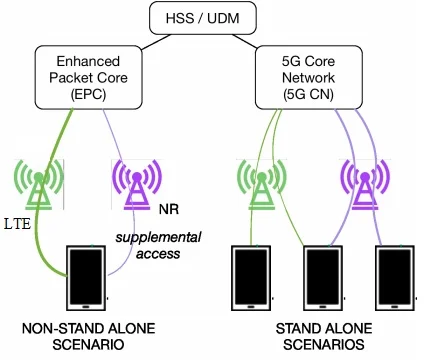Featured post
- Get link
- X
- Other Apps
5G NR Deployment Scenarios Or Modes-NSA, SA, Homogeneous, Heterogeneous
5G NR Deployment Scenarios Or Modes-NSA, SA, Homogeneous, Heterogeneous
In order to have support for both the RATs (i.e. LTE and 5G NR), mobile phones or smartphones should support both the RATs. Only LTE supported smartphones will not work in 5G NR network. Similarly 5G NR supported smartphones will not work in LTE network provided it supports LTE RAT.
5G NR Architecture

• The figure-1 depicts 5G NR overall architecture. This is as defined in the 3GPP TS 38.300 specification.
• gNB node providing NR user plane and control plane protocol terminations towards the UE, and connected via the NG interface to the 5GC.
• ng-eNB node providing E-UTRA user plane and control plane protocol terminations towards the UE, and connected via the NG interface to the 5GC.
Refer 5G Basic Tutorial >>.
5G NR Non-Standalone (NSA) Mode | 5G NR Standalone (SA) Mode

There are two main modes viz. Non-Standalone (NSA) and Standalone (SA) based on individual or combined RAT operation. This is shown in the figure-2. Following section mentions difference between 5G Non-standalone and standalone UE modes.
5G NR Non-Standalone (NSA) Mode
• In this mode, connection to both LTE cell and 5G cell are mandatory.
• In this Non-standalone mode, LTE is used for control (C-Plane) functions e.g. call origination, call termination, location registration etc where as 5G NR will focuse on U-Plane alone.
• In this mode, 5G radio control parameters are exchanged via LTE RAT. To have this, functions should be added to eNB.
• UE monitors paging channels on LTE RAT.
5G NR Standalone (SA) Mode
• In this mode, UE works by 5G RAT alone and LTE RAT is not needed.
• In this mode, 5G cell is used for both C-Plane (Control Plane) and U-Plane (User Plane) to take care of both signaling and information transfer.
• In this mode, 5G radio control parameters are exchanged via 5G NR RAT.
• UE monitors paging channels on 5G cell.

As shown in the figure-3, Non-standalone mode UE requires LTE eNB cell and EPC for signaling and information transfer takes place over 5G NR cell. Standalone mode UE requires 5G NR cell and 5G CN (Core Network) for both signaling and information transfer.
5G NR Homogeneous Mode | 5G NR Heterogeneous Mode
There are two modes viz. Homogeneous and Non-homogeneous (i.e. Heterogeneous) based on coverage or capacity requirements in LTE and 5G RATs .
• Homogeneous Mode: In this mode, both LTE Base Station (i.e. ng-eNB) and 5G NR Base Station (i.e. gNB) provide same coverage.
• HeterogeneousMode: In this mode, both LTE and 5G NR base stations serve different coverage areas. The cell having less coverage will support higher capacity and vice versa. Hence LTE and 5G NR cells function either as small cell or as macro cell and vice versa.
- Get link
- X
- Other Apps
Popular Posts
5G NR MAC Layer-Architecture, Channel Mapping, Procedures
- Get link
- X
- Other Apps
5G NR TBS Calculation | 5G NR Transport Block Size Calculation
- Get link
- X
- Other Apps

Comments
Post a Comment